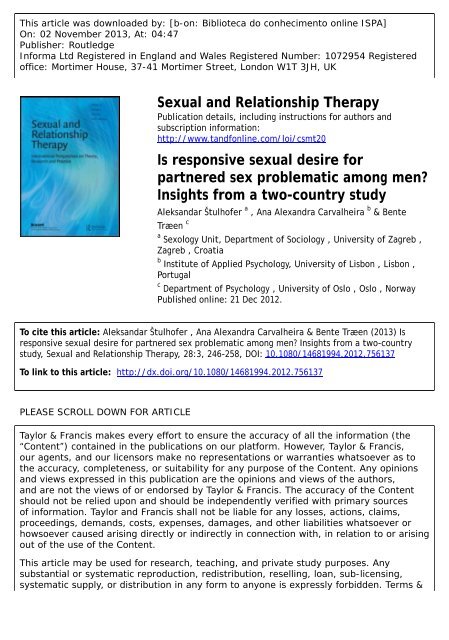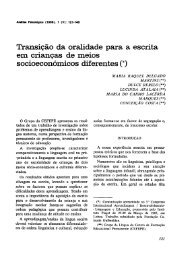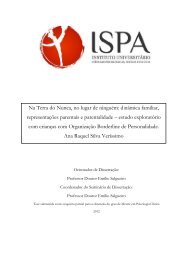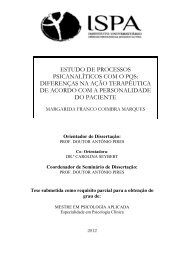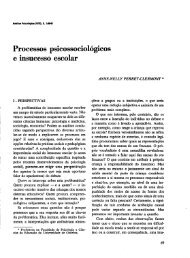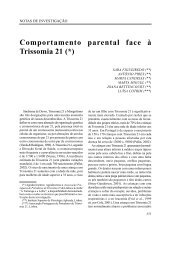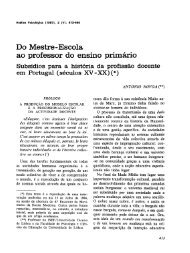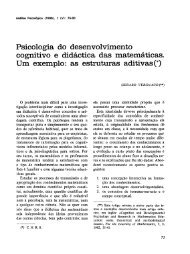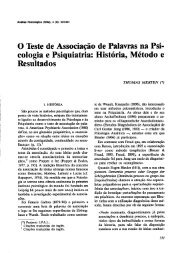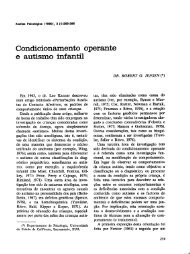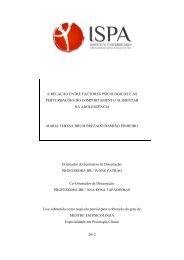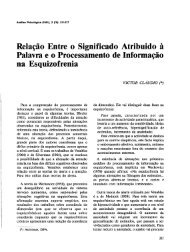Sexual and Relationship Therapy Is responsive sexual desire for ...
Sexual and Relationship Therapy Is responsive sexual desire for ...
Sexual and Relationship Therapy Is responsive sexual desire for ...
Create successful ePaper yourself
Turn your PDF publications into a flip-book with our unique Google optimized e-Paper software.
This article was downloaded by: [b-on: Biblioteca do conhecimento online ISPA]On: 02 November 2013, At: 04:47Publisher: RoutledgeIn<strong>for</strong>ma Ltd Registered in Engl<strong>and</strong> <strong>and</strong> Wales Registered Number: 1072954 Registeredoffice: Mortimer House, 37-41 Mortimer Street, London W1T 3JH, UK<strong>Sexual</strong> <strong>and</strong> <strong>Relationship</strong> <strong>Therapy</strong>Publication details, including instructions <strong>for</strong> authors <strong>and</strong>subscription in<strong>for</strong>mation:http://www.t<strong>and</strong>fonline.com/loi/csmt20<strong>Is</strong> <strong>responsive</strong> <strong>sexual</strong> <strong>desire</strong> <strong>for</strong>partnered sex problematic among men?Insights from a two-country studyAleks<strong>and</strong>ar Štulhofer a , Ana Alex<strong>and</strong>ra Carvalheira b & BenteTræen ca Sexology Unit, Department of Sociology , University of Zagreb ,Zagreb , Croatiab Institute of Applied Psychology, University of Lisbon , Lisbon ,Portugalc Department of Psychology , University of Oslo , Oslo , NorwayPublished online: 21 Dec 2012.To cite this article: Aleks<strong>and</strong>ar Štulhofer , Ana Alex<strong>and</strong>ra Carvalheira & Bente Træen (2013) <strong>Is</strong><strong>responsive</strong> <strong>sexual</strong> <strong>desire</strong> <strong>for</strong> partnered sex problematic among men? Insights from a two-countrystudy, <strong>Sexual</strong> <strong>and</strong> <strong>Relationship</strong> <strong>Therapy</strong>, 28:3, 246-258, DOI: 10.1080/14681994.2012.756137To link to this article: http://dx.doi.org/10.1080/14681994.2012.756137PLEASE SCROLL DOWN FOR ARTICLETaylor & Francis makes every ef<strong>for</strong>t to ensure the accuracy of all the in<strong>for</strong>mation (the“Content”) contained in the publications on our plat<strong>for</strong>m. However, Taylor & Francis,our agents, <strong>and</strong> our licensors make no representations or warranties whatsoever as tothe accuracy, completeness, or suitability <strong>for</strong> any purpose of the Content. Any opinions<strong>and</strong> views expressed in this publication are the opinions <strong>and</strong> views of the authors,<strong>and</strong> are not the views of or endorsed by Taylor & Francis. The accuracy of the Contentshould not be relied upon <strong>and</strong> should be independently verified with primary sourcesof in<strong>for</strong>mation. Taylor <strong>and</strong> Francis shall not be liable <strong>for</strong> any losses, actions, claims,proceedings, dem<strong>and</strong>s, costs, expenses, damages, <strong>and</strong> other liabilities whatsoever orhowsoever caused arising directly or indirectly in connection with, in relation to or arisingout of the use of the Content.This article may be used <strong>for</strong> research, teaching, <strong>and</strong> private study purposes. Anysubstantial or systematic reproduction, redistribution, reselling, loan, sub-licensing,systematic supply, or distribution in any <strong>for</strong>m to anyone is expressly <strong>for</strong>bidden. Terms &
Downloaded by [b-on: Biblioteca do conhecimento online ISPA] at 04:47 02 November 2013Conditions of access <strong>and</strong> use can be found at http://www.t<strong>and</strong>fonline.com/page/terms<strong>and</strong>-conditions
<strong>Sexual</strong> <strong>and</strong> <strong>Relationship</strong> <strong>Therapy</strong>, 2013Vol. 28, No. 3, 246–258, http://dx.doi.org/10.1080/14681994.201 2.756137Downloaded by [b-on: Biblioteca do conhecimento online ISPA] at 04:47 02 November 2013<strong>Is</strong> <strong>responsive</strong> <strong>sexual</strong> <strong>desire</strong> <strong>for</strong> partnered sex problematic among men?Insights from a two-country studyAleks<strong>and</strong>ar Sˇ tulhofer a *, Ana Alex<strong>and</strong>ra Carvalheira b <strong>and</strong> Bente Træen ca Sexology Unit, Department of Sociology, University of Zagreb, Zagreb, Croatia; b Institute ofApplied Psychology, University of Lisbon, Lisbon, Portugal; c Department of Psychology,University of Oslo, Oslo, Norway(Received 21 May 2012; final version received 3 December 2012)In contrast to the body of research focusing on female <strong>sexual</strong> <strong>desire</strong>, there hasbeen very little research into patterns of male <strong>sexual</strong> <strong>desire</strong>. This study addressesthis deficiency in the literature by providing empirical answers to the followingthree questions: (1) is there a pattern of <strong>responsive</strong> <strong>sexual</strong> <strong>desire</strong> – defined as beingpredominantly receptive to a partner’s initiation of <strong>sexual</strong> activity withoutinitially desiring it – among men? (2) <strong>Is</strong> this pattern associated with lower levels of<strong>sexual</strong> health than a more spontaneous pattern of male <strong>desire</strong>? (3) Are existingclinical observations regarding possible causes of reduced interest in partnered sexuseful <strong>for</strong> underst<strong>and</strong>ing the more <strong>responsive</strong> men’s <strong>sexual</strong> <strong>desire</strong>? A large onlinesurvey about men’s <strong>sexual</strong> interest was conducted in 2011 among 2215 Norwegian<strong>and</strong> Portuguese men aged 18–75 years (the average age in the sample was 36.5years). Sociodemographic, health-related, socio<strong>sexual</strong> <strong>and</strong> relationship-relatedin<strong>for</strong>mation was collected. Three distinct patterns of male <strong>sexual</strong> <strong>desire</strong> wereobserved: decreased (23.6%), <strong>responsive</strong> (2.5%) <strong>and</strong> spontaneous (73.9%) <strong>desire</strong>patterns. Men in the more <strong>responsive</strong> <strong>and</strong> spontaneous <strong>desire</strong> groups significantlydiffered from participants in the decreased <strong>desire</strong> group, as they reportedsignificantly higher levels of <strong>sexual</strong> interest, <strong>sexual</strong> satisfaction <strong>and</strong> frequency of<strong>sexual</strong> intercourse <strong>and</strong> were less likely to have experienced <strong>sexual</strong> healthdifficulties in the past 12 months. Interestingly, participants with more <strong>responsive</strong><strong>and</strong> spontaneous <strong>desire</strong> patterns were indistinguishable in terms of a number ofsociodemographic, health-related, socio<strong>sexual</strong> <strong>and</strong> relationship-related variables.The sole predictor of the <strong>responsive</strong> <strong>sexual</strong> <strong>desire</strong> pattern was proneness torelationship-related <strong>sexual</strong> boredom. Clinical observations about the roles ofnegative emotions, relationship strain <strong>and</strong> specific <strong>sexual</strong> arousal patterns(homoerotic, autoerotic <strong>and</strong>/or paraphilic) in the etiology of hypoactive <strong>sexual</strong><strong>desire</strong> did not seem relevant <strong>for</strong> men with <strong>responsive</strong> <strong>desire</strong>.Keywords: <strong>sexual</strong> <strong>desire</strong>; men; <strong>sexual</strong> health; <strong>responsive</strong> <strong>desire</strong> patternIntroductionIn a series of influential papers, Basson (2000, 2001, 2002) proposed a new model ofhuman <strong>sexual</strong> response based primarily on her underst<strong>and</strong>ing of <strong>and</strong> evidenceregarding female <strong>sexual</strong>ity. Unlike the st<strong>and</strong>ard <strong>sexual</strong> response model (developed byMasters <strong>and</strong> Johnson <strong>and</strong> appended by Kaplan), which is linear <strong>and</strong> starts with a*Corresponding author. Email: astulhof@ffzg.hrÓ 2013College of <strong>Sexual</strong> <strong>and</strong> <strong>Relationship</strong> Therapists
<strong>Sexual</strong> <strong>and</strong> <strong>Relationship</strong> <strong>Therapy</strong> 247Downloaded by [b-on: Biblioteca do conhecimento online ISPA] at 04:47 02 November 2013spark-like occurrence of <strong>sexual</strong> interest (<strong>desire</strong>), this cyclical model was advocated asa more accurate representation of the <strong>sexual</strong> response of women in long-termrelationships (Basson, 2001, 2002; Hayes, 2011). One of the core ideas embedded inthe model – which has since substantially influenced both research <strong>and</strong> clinicalpractice – was that <strong>responsive</strong> female <strong>sexual</strong> <strong>desire</strong> (i.e., being <strong>sexual</strong>ly receptiverather than ‘‘spontaneous’’) is not pathological. In other words, a woman’s <strong>sexual</strong>neutrality at the onset of a <strong>sexual</strong> encounter is not an obstacle <strong>for</strong> satisfactory <strong>sexual</strong>experience <strong>and</strong>, hence, it need not be viewed as problematic. Because <strong>desire</strong> mayfollow arousal that was triggered by external erotic stimuli, a lack of morespontaneous <strong>desire</strong> caused by internal erotic dynamics such as <strong>sexual</strong> thoughts is nota sign of inhibited <strong>sexual</strong> interest (Basson, 2002; Carvalheira, Brotto, & Leal, 2010;Goldhammer & McCabe, 2011).Although Basson (2000) explicitly linked her model (primarily) to women’s<strong>sexual</strong> experiences, the question about the utility of the concept of <strong>responsive</strong> <strong>desire</strong><strong>for</strong> underst<strong>and</strong>ing male <strong>sexual</strong> response seems relevant, especially given theindications that male patterns of <strong>sexual</strong> <strong>desire</strong> <strong>and</strong> arousal may be more complex(particularly as men age) than is usually acknowledged (Bancroft, 2009; Jenssen,McBride, Yarber, Hill, & Butler, 2008). The fact that the cyclical model has recentlybeen challenged – as a couple of studies suggested that it may be more descriptive ofwomen with <strong>sexual</strong> concerns <strong>and</strong> deficits in <strong>desire</strong> than of those with no <strong>sexual</strong>difficulties (Giles & McCabe, 2009; S<strong>and</strong> & Fisher, 2007) – does not negate the abovereasoning.What do we know about more <strong>responsive</strong>, or receptive (Meuleman & vanLankveld, 2005), <strong>sexual</strong> <strong>desire</strong> (MRD) among men? There is little empirical evidenceon male <strong>sexual</strong> <strong>desire</strong> in general (Brotto, 2010; DeRogatis et al., 2012; McCarthy &McDonald, 2009). To the best of our knowledge, there has been no attempt to studythe prevalence <strong>and</strong>/or characteristics of the predominantly <strong>responsive</strong> pattern of<strong>sexual</strong> <strong>desire</strong> among men. However, a couple of studies analyzed consenting,unwanted <strong>sexual</strong> experiences among male college students. In a three-country study,Sprecher, Hatfield, Cortese, Potapovc <strong>and</strong> Levitskaya (1994) found that 30–35% ofmale students from one Russian, two Japanese <strong>and</strong> five American universitiesreported having sex without really wanting it. In the other study, which used a sexdiary method, 21 of the 80 surveyed men (26.3%) claimed one or more episodes ofunwanted <strong>sexual</strong> activity (O’Sullivan & Rice Allgeier, 1998). A host of reasons weregiven by participants to explain their consent to unwanted sex, including relationship-supporting<strong>and</strong> intimacy-promoting reasons. Notably, a majority of malestudents (52.3%) reported no negative outcomes related to engaging in unwanted sex(O’Sullivan & Rice Allgeier, 1998). Comparably, approximately one quarter of men(26%) in a r<strong>and</strong>om community sample of cohabiting/married Norwegian couplesacknowledged the experience of ‘‘obligatory sex’’ (Træen & Skogerbø, 2009), whichwas defined as having sex ‘‘even though you don’t feel any <strong>desire</strong>, just to satisfy yourpartner’’. Among men, correlates of obligatory sex were partner communicationabout <strong>sexual</strong> needs <strong>and</strong> sharing <strong>sexual</strong> fantasies.Although documenting the prevalence of unwanted sex among young adult men,these studies provide little in<strong>for</strong>mation about the existence of a specific pattern of<strong>sexual</strong> <strong>desire</strong>. Are there men who can be characterized as having MRD? If so, doesthe pattern substantially differ from hypoactive <strong>desire</strong> disorder (HSSD)? One way totest this hypothesis would be to explore whether men with MRD display some ormost of the characteristics associated with HSSD. Anecdotal evidence from sex
<strong>Sexual</strong> <strong>and</strong> <strong>Relationship</strong> <strong>Therapy</strong> 249MeasuresDownloaded by [b-on: Biblioteca do conhecimento online ISPA] at 04:47 02 November 2013Patterns of <strong>sexual</strong> <strong>desire</strong>The participants who reported a decrease in <strong>sexual</strong> interest in the past six months(‘‘Did you notice a decrease in your <strong>sexual</strong> interest [i.e., <strong>sexual</strong> thoughts <strong>and</strong> fantasies,motivation to have sex, being receptive to have sex, etc.] during the past 6 months?’’)were considered men with decreased <strong>sexual</strong> <strong>desire</strong>. Men who did not report thedecrease in <strong>sexual</strong> interest, but who stated that in the same timeframe they ‘‘often oralways engaged in <strong>sexual</strong> activity without initially wanting it (‘‘How often in the past6 months did you engage in <strong>sexual</strong> activity just because your partner wanted it, that iswithout really desiring sex?), were categorized as men with MRD. All otherparticipants – that is, men without reduced <strong>sexual</strong> interest who stated that they onlyinfrequently (from ‘‘never’’ to ‘‘sometimes’’) had sex solely because their partnerwanted it – were considered men with more spontaneous pattern of <strong>sexual</strong> <strong>desire</strong>.Current level of <strong>sexual</strong> <strong>desire</strong>Current level of <strong>sexual</strong> <strong>desire</strong> was assessed by two moderately strongly correlateditems (r S ¼ .63, p 5 .001): ‘‘How would you rate the degree of your current <strong>sexual</strong>interest?’’ <strong>and</strong> ‘‘How would you rate your current <strong>desire</strong> <strong>for</strong> <strong>sexual</strong> activity?’’ Bothindicators used the same 5-point scale, ranging from 1 ¼ very high to 5 ¼ very lowor non-existent, to anchor answers. The two items were summed <strong>and</strong> reversed so thathigher scores denoted more <strong>sexual</strong> <strong>desire</strong>.<strong>Sexual</strong> difficulties<strong>Sexual</strong> difficulties were measured by six yes/no questions from the National Surveyof <strong>Sexual</strong> Attitudes <strong>and</strong> Lifestyles (Mercer et al., 2003) asking about inability toreach orgasm, reaching orgasm too quickly, pain during <strong>sexual</strong> intercourse, lack ofinterest in sex, unpleasurable sex, feeling anxious about per<strong>for</strong>ming <strong>sexual</strong>ly <strong>and</strong>trouble achieving or maintaining erection. Those who had no such experienceslasting at least 2 months in the past 12 months were instructed to check the option ‘‘Ihave experienced none of these difficulties’’.Frequency of <strong>sexual</strong> intercourseFrequency of <strong>sexual</strong> intercourse in the past three months was reported using a sixpointscale (1 ¼ never, 2 ¼ once, 3 ¼ two or three times, 4 ¼ once a week,5 ¼ several times a week, 6 ¼ daily or more often). A similar scale (ranging from1 ¼ never to 7 ¼ daily) was used to anchor answers regarding the frequency ofmasturbation in the past six months.<strong>Sexual</strong> satisfaction<strong>Sexual</strong> satisfaction was measured using a short version (k ¼ 12) of the recentlyvalidated New Scale of <strong>Sexual</strong> Satisfaction (Sˇ tulhofer, Busˇ ko, & Brouillard, 2011).Participants were asked to rate their satisfaction with the quality of their orgasmsduring the past six months, the pleasure they provide to their partner, the partner’s<strong>sexual</strong> creativity, the frequency of <strong>sexual</strong> activity <strong>and</strong> so on. The scale had high
250A. Sˇtulhofer et al.internal consistency in both subsamples (Cronbach’s a ¼ .92 <strong>and</strong> .93). Higher scoresindicated more <strong>sexual</strong> satisfaction.Downloaded by [b-on: Biblioteca do conhecimento online ISPA] at 04:47 02 November 2013Sociodemographic characteristicsSociodemographic characteristics were assessed by asking participants how oftenthey attend religious services (an eight-point scale <strong>for</strong> anchoring answers wasrecoded into 1 ¼ never, 2 ¼ up to several times a year, 3 ¼ once a month or morefrequently), what is the highest level of <strong>for</strong>mal schooling they completed (theindicator was dichotomized into 0 ¼ secondary or less <strong>and</strong> 1 ¼ college education),how they would compare their total household income in the past year to thenational average (a five-point scale, ranging from 1 ¼ substantially below averageincome to 5 ¼ substantially above average income, was used), how many years havethey been in the current relationship <strong>and</strong> whether they have children.Health-related characteristicsHealth-related characteristics included Body Mass Index (participants were askedabout their height <strong>and</strong> weight), general health status (participants were askedwhether they had any of 13 listed health problems, which included heart disease,diabetes, high blood pressure, chronic pain <strong>and</strong> so on [the additive indicator wasdichotomized into 0 ¼ healthy <strong>and</strong> 1 ¼ one or more illnesses reported]), job-relatedstress (‘‘In the past 12 months did you have any stressful experience on the job?’’)<strong>and</strong> the SCL_ANX4 <strong>and</strong> SCL-DEP6 scales measuring anxiety (four items) <strong>and</strong>depression (six items), respectively (Søgaard, 2009). The two composite indicatorshad acceptable internal consistency in this study (Cronbach’s a were .74 <strong>and</strong> .83) <strong>and</strong>were combined due to their strong interrelatedness (r ¼ .73, p 5 .001). Higherscores denoted higher levels of anxiety <strong>and</strong> depression.<strong>Relationship</strong>-related characteristics<strong>Relationship</strong>-related characteristics were measured using the Emotional IntimacyScale (Sinclair & Dowdy, 2005: Cronbach’s a <strong>for</strong> the scale was .90 in this study –higher scores indicate stronger relationship intimacy) <strong>and</strong> the seven-item BodyAppearance Evaluation dimension from the Multidimensional Body-Self RelationsQuestionnaire (Cash & Labarge, 1996; Cash & Szymanski, 1995; Cronbach’s a ¼.91 – higher scores reflected a more positive body image). Men were also asked abouthow <strong>sexual</strong>ly attractive (from 1 ¼ very attractive to 5 ¼ very unattractive) theyfound their current partner/spouse.<strong>Sexual</strong>ity-related characteristics<strong>Sexual</strong>ity-related characteristics were the number of <strong>sexual</strong> partners in the past fiveyears <strong>and</strong> the gender of <strong>sexual</strong> partners during the same period. A shortened, fouritemversion of <strong>Sexual</strong> Boredom Scale (Watt & Ewing, 1996) was used to assessproneness to <strong>sexual</strong> satiation in a relationship. The scale had acceptable reliability inthis study (Cronbach’s a ¼ .85) but needed to be categorized into quartiles becauseof extreme skewness. Placement into a higher quartile denotes more <strong>sexual</strong> boredom.Frequency of pornography use in the past 12 months was measured on an 8-point
<strong>Sexual</strong> <strong>and</strong> <strong>Relationship</strong> <strong>Therapy</strong> 251scale ranging from 1 ¼ never to 8 ¼ daily or more often. Problematic use ofpornography in the past year was a composite indicator including the following threeitems: (1) ‘‘I feel that my use of pornography negatively affects my sex life’’, (2) ‘‘Ifeel that I have became dependent on pornography, i.e., that I could not control myuse of pornography anymore’’ <strong>and</strong> (3) ‘‘pornography caused problems in myrelationship’’. A four-point scale, ranging from 1 ¼ not at all to 4 ¼ a great deal,was used. Because of their limited range <strong>and</strong> skewness, summed scores weredichotomized into 0 ¼ median value (of three) <strong>and</strong> 1 ¼ above median value.Downloaded by [b-on: Biblioteca do conhecimento online ISPA] at 04:47 02 November 2013ResultsMost surveyed men had attended college or a higher level of education (63.1%),followed by those who completed secondary education (35.6%). Over two-thirds ofthe men were employed full-time (72.7%), while 9.0% reported being unemployed.Although the majority of participants stated that their household incomes in the pastyear were above average (49.4%), less than a fifth of surveyed men (18.8%) reportedbelow-average incomes. Over one-third of participants (37.2%) were married, 20.0%were cohabitating, 28.7% were in a relationship but not living together with theirpartner <strong>and</strong> 14.13% stated that they were single at the time of the survey. Theparticipants’ median length of relationship/marriage was seven years (M ¼ 8.5,SD ¼ 5.60), with one-fourth of participants (25.2%) reporting a relationship ormarriage of 15 years or longer. Almost half of the surveyed men had children(48.3%). Regarding religiosity, 50.1% of participants reported that they never attendreligious services. Only 10.2% of surveyed men attended religious ceremonies moreoften than several times a year.Considering socioeconomic <strong>and</strong> sociocultural differences between the EuropeanNorth (Norway) <strong>and</strong> South (Portugal), a number of predictable differences in thesociodemographic characteristics of the two subsamples were observed. More Norwegianmen (77.7%) than Portuguese men (71.4%) were employed full-time (w 2 [4] ¼ 11.25,p 5 .05) <strong>and</strong> reported living in a cohabitating relationship (23.9 <strong>and</strong> 19.0%, respectively,w 2 [3] ¼ 24.07, p 5 .001). In addition, a substantially higher proportion of Norwegianparticipants, compared to participants in the Portuguese sample, stated that they neverattend religious services (68.7 versus 45.5%, w 2 [2] ¼ 58.71, p 5 .001).Three patterns of male <strong>sexual</strong> <strong>desire</strong>Over one-fifth of the surveyed men reported experiencing reduced <strong>sexual</strong> <strong>desire</strong> in thepast six months (n ¼ 523, 23.6%). The proportion was significantly larger (w 2 [2] ¼27.53, p 5 .001) in the Norwegian subsample (32.6%) than in the Portuguesesubsample (21.4%). Of the men who did not experience reduced <strong>desire</strong>, only 56(2.5% of the total sample – 3.4% of the Norwegian subsample <strong>and</strong> 2.3% of thePortuguese subsample) reported MRD. As expected, those with neither decreasednor <strong>responsive</strong> <strong>sexual</strong> <strong>desire</strong>, that is, men with spontaneous <strong>desire</strong> pattern,constituted the majority of participants (n ¼ 1636, 73.9%).Are men with MRD distinguishable from men with self-reported decreased <strong>desire</strong>?To assess how different the three groups of men were (particularly the participantswho reported decreased <strong>sexual</strong> <strong>desire</strong> <strong>and</strong> those who reported MRD in the past six
252A. Sˇtulhofer et al.Downloaded by [b-on: Biblioteca do conhecimento online ISPA] at 04:47 02 November 2013months), a number of univariate ANOVAs were conducted. As shown in Table 1,the groups scored significantly differently on three of the four indicators: currentlevel of <strong>sexual</strong> <strong>desire</strong>/interest (F ¼ 311.53, p 5 .001), frequency of <strong>sexual</strong> intercoursein the past three months (F ¼ 40.43, p 5 .001), <strong>and</strong> <strong>sexual</strong> satisfaction (F ¼ 140.0,p 5 .001). In all three cases, the reduced <strong>desire</strong> group differed significantly(p 5 .001) from the two other groups of men.The above findings did not seem to reflect country-specific differences in the threedomains, as no consistent between-country patterns were found. While no significantdifferences were found in current levels of <strong>sexual</strong> <strong>desire</strong> <strong>and</strong> interest, Portuguese menreported a significantly higher frequency of sex than did Norwegian participants(t[650] ¼ 4.17, p 5 .001), which may have been related to their higher <strong>sexual</strong>satisfaction (t[611] ¼ 4.49, p 5 .001) or to a somewhat lower average age <strong>and</strong>shorter relationship duration (t[536.3] ¼74.30, p 5 .001). 1 Interestingly, Norwegianparticipants had a significantly higher frequency of masturbation (t[2207] ¼76.0, p 5 .001).Finally, there was a statistically significant difference in the proportion ofparticipants who reported that they experienced no <strong>sexual</strong> difficulties (other than‘‘lacking interest in sex’’) in the past 12 months among the three <strong>desire</strong> patterngroups (w 2 [2] ¼ 120.09, p 5 .001). Only 34.1% of participants in the reduced <strong>desire</strong>group reported having no <strong>sexual</strong> difficulties, in comparison to 64% in the morespontaneous <strong>desire</strong> group <strong>and</strong> 61.2% in the MRD group. The difference between themore spontaneous <strong>and</strong> MRD groups was not significant (p 5 .08).What differentiates men with more spontaneous <strong>sexual</strong> <strong>desire</strong> from men with MRD?As men characterized with MRD differed significantly <strong>and</strong> consistently fromparticipants who reported a recent decrease in <strong>sexual</strong> <strong>desire</strong> but not from those in themore spontaneous <strong>desire</strong> group, univariate <strong>and</strong> multivariate logistic analyses werecarried out to explore potential predictors of the membership in the morespontaneous versus MRD groups. The choice of independent variables, such asnegative emotions (Brotto, 2010; Meuleman & van Lankveld, 2005), specific <strong>sexual</strong>arousal pattern (McCarthy & Ginsberg, 2008; McCarthy & McDonald, 2009) <strong>and</strong>relationship-related issues (Bancroft, 2009; Schnarch, 1991), was guided by theTable 1. Desire/interest, frequency of <strong>sexual</strong> intercourse, frequency of masturbation <strong>and</strong><strong>sexual</strong> satisfaction among three groups of men with different <strong>sexual</strong> <strong>desire</strong> pattern.Decreased<strong>desire</strong> group(n ¼ 523)More spontaneous<strong>desire</strong> group(n ¼ 1636)More <strong>responsive</strong><strong>desire</strong> group(n ¼ 56) Welch a /F bM (SD) M (SD) M (SD) (p5)<strong>Sexual</strong> <strong>desire</strong>/interest 4.71 (1.67) 6.54 (1.36) 6.00 (1.83) 255.96 a,c (.001)Frequency of <strong>sexual</strong> 3.69 (1.11) 4.16 (1.07) 4.41 (1.04) 38.65 a,c (.001)intercourseFrequency of 5.18 (1.56) 5.16 (1.57) 5.11 (1.82) .04 b (.95)masturbation<strong>Sexual</strong> satisfaction 37.56 (8.62) 45.0 (8.59) 42.89 (9.70) 140.0 b,d (.001)Notes: a Welch test <strong>for</strong> equality of means; b F-test; c Group 1 6¼ group 2, 3 (Tamhane’s post hoc test,p 5 .001); d group 1 6¼ group 2, 3 (Bonferroni post hoc test, p 5 .001).
<strong>Sexual</strong> <strong>and</strong> <strong>Relationship</strong> <strong>Therapy</strong> 253Downloaded by [b-on: Biblioteca do conhecimento online ISPA] at 04:47 02 November 2013literature on the correlates of male <strong>sexual</strong> <strong>desire</strong> disorders. Univariate logisticregression analysis controlled <strong>for</strong> a number of sociodemographic <strong>and</strong> socio<strong>sexual</strong>variables, as well as <strong>for</strong> two general health indicators. Controlling <strong>for</strong> age,independent variables significantly associated with the outcome at the univariatelevel were entered in multivariate assessment. Due to a small number of participantsin the MRD group, the multivariate model was a priori limited to four independentvariables (including age).As presented in Table 2, only one indicator was significantly correlated with theoutcome at univariate level. Participants in the highest quartile of <strong>Sexual</strong> BoredomScale scores were over three times (OR ¼ 3.17, p 5 .01) more likely to exhibit theMRD pattern than those scoring in the lowest quartile. Controlling <strong>for</strong> participants’age did not affect this association. A non-significant result on Hosmer <strong>and</strong>Table 2. Correlates of the spontaneous versus <strong>responsive</strong> male <strong>sexual</strong> <strong>desire</strong> patterns(n ¼ 1692).OR (95% CI)AOR a (95% CI)Age 1.02 (.99–1.04) 1.02 (.99–1.04)ReligiosityNot religious (reference)Somewhat religiousVery religious11.50 (.85–2.64)1.28 (.51–3.18)College educated .81 (.47–1.39)Relative household income .96 (.75–1.24)Length of current relationship .98 (.93–1.04)Having children .92 (.54–1.57)Body Mass Index 1.01 (.94–1.08)Job-related stress 1.24 (.72–2.14)Health problems .84 (.48–1.48)Anxiety/depression 1.03 (.99–1.08)Body image 1.00 (.95–1.06)<strong>Sexual</strong> boredom1 st quartile (reference)2 nd quartile3 rd quartile4 th quartile11.27 (.58–2.77)1.80 (.81–3.00)3.17* (1.49–6.76)<strong>Relationship</strong> intimacy .98 (.91–1.05)Partner’s attractivenessVery attractive (reference)1Somewhat attractive1.27 (.70–2.31)Not attractive1.87 (.76–4.62)Number of <strong>sexual</strong> partners in the past five years1 (reference)2–45One or more male <strong>sexual</strong> partnersin the past five yearsPornography useSeveral times per year or less (reference)Monthly to once per weekSeveral times per week or more1.74 (.36–1.50)1.52 (.83–2.80)2.02 (.89–4.47)1.61 (.30–1.25).80 (.44–1.47)Problematic use of pornography 1.27 (.69–2.32)11.25 (.57–2.73)1.76 (.79–3.91)3.05* (1.43–6.51)Notes: a Odds ratios adjusted <strong>for</strong> the contribution of the other independent variable in the model;*p 5 .01.
254A. Sˇtulhofer et al.Lemeshow’s test (w 2 [8] ¼ 2.37, p 5 .97) suggested an acceptable fit of themultivariate logistic regression model with two independent variables.Downloaded by [b-on: Biblioteca do conhecimento online ISPA] at 04:47 02 November 2013DiscussionThis study explored the existence <strong>and</strong> characteristics of MRD. Using large-scaleconvenience samples of Norwegian <strong>and</strong> Portuguese men, we found that a smallminority (2–3%) of participants in both countries reported this pattern of <strong>sexual</strong><strong>desire</strong>, which was consistently <strong>and</strong> substantially different from the decreased <strong>sexual</strong><strong>desire</strong> pattern. Men with MRD exhibited substantially higher levels of self-reported<strong>sexual</strong> interest, frequency of <strong>sexual</strong> intercourse <strong>and</strong> <strong>sexual</strong> satisfaction than men whoreported decreased <strong>desire</strong>. In addition, the two groups differed in the prevalence of<strong>sexual</strong> difficulties experienced in the past 12 months. In comparison to men withMRD, participants with self-reported reduced <strong>desire</strong> were almost twice as likely toreport the presence of one or more <strong>sexual</strong> health difficulties.Unexpectedly, men with MRD were indistinguishable from participants withspontaneous <strong>sexual</strong> <strong>desire</strong> across a number of sociodemographic, health-related <strong>and</strong>socio<strong>sexual</strong> characteristics. The only significant difference between the two groups ofmen was their scores on the relationship-related <strong>sexual</strong> boredom scale: men withMRD scored significantly higher on this scale than participants with spontaneous<strong>desire</strong>. As a similar frequency of dyadic <strong>sexual</strong> activity was observed among menwith MRD <strong>and</strong> those with more spontaneous <strong>sexual</strong> <strong>desire</strong>, men with MRD seem tohave been fully receptive to their partner’s initiative, to the extent that their levels ofsatisfaction with their <strong>sexual</strong> lives were similar to the ones reported by men with thepattern of spontaneous <strong>desire</strong>.The reasons <strong>for</strong> elevated <strong>sexual</strong> boredom scores among men with MRD wereimpossible to explore in this study since the questionnaire used did not contain therelevant indicators. It could be hypothesized, however, that men with MRD were notonly more prone to <strong>sexual</strong> boredom (<strong>for</strong> unknown reasons), but that they alsodisplayed a specific variant of <strong>sexual</strong> boredom – one that does not substantially affect<strong>sexual</strong> receptivity. This is likely to be more relevant <strong>for</strong> men with primary rather thansecondary MRD. Another related issue may be the learned <strong>and</strong> internalizederoticization of personal <strong>sexual</strong> passivity – paired with a preference <strong>for</strong> the partner’s<strong>sexual</strong> assertiveness <strong>and</strong> perceived control over <strong>sexual</strong> activity. Although wecollected no data that would support this speculation, future assessments of maleMRD need to pay attention to the issue of <strong>sexual</strong> boredom <strong>and</strong> its dynamics, scope<strong>and</strong> defining characteristics, as well as to a possible erotic preference <strong>for</strong> passivity.This study’s findings are in<strong>for</strong>mative when addressing the question of whetherMRD shares a similar etiology with hypoactive <strong>sexual</strong> <strong>desire</strong> disorder. Leaving asidephysical pathology, three major pathways to a chronic deficit of <strong>sexual</strong> interest havebeen suggested <strong>and</strong> described in the literature: (1) negative emotions, such asdepression, anxiety <strong>and</strong> anger (Brotto, 2010; Meuleman & van Lankveld, 2005), (2)relationship problems (Bancroft, 2009; Schnarch, 1991) <strong>and</strong> (3) a specific <strong>sexual</strong>arousal pattern that cannot be enacted in the present relationship (McCarthy &Ginsberg, 2008; McCarthy & McDonald, 2009). Although our study was notdesigned to directly test the above mechanisms, it enabled a partial assessment of theproposed pathways.No difference in depression <strong>and</strong> anxiety levels was observed between men withMRD <strong>and</strong> those with more spontaneous <strong>desire</strong> patterns (participants taking
<strong>Sexual</strong> <strong>and</strong> <strong>Relationship</strong> <strong>Therapy</strong> 255Downloaded by [b-on: Biblioteca do conhecimento online ISPA] at 04:47 02 November 2013antidepressants at the time of the survey were excluded from the analyses). Ourfindings indicate that apart from anger – which was not measured in the study –negative emotions are not defining characteristics of MRD. Similarly, the fact thatthe two groups of men did not differ in terms of reported levels of relationshipintimacy (cf. Table 2) suggests that relationship strain is an unlikely source of MRD.The third pathway (the variant <strong>sexual</strong> arousal pattern) entails at least threedistinct mechanisms responsible <strong>for</strong> decreased male <strong>desire</strong> in hetero<strong>sexual</strong> relationships(McCarthy & Ginsberg, 2008); (1) homoerotic <strong>desire</strong>, (2) autoerotic preoccupation(i.e., masturbation is preferred to dyadic <strong>sexual</strong> activity) <strong>and</strong> (3) paraphilicinterest. All three mechanisms were assessed, although not robustly, in themultivariate regression model presented in Table 2. No evidence was found <strong>for</strong> therole of homoerotic <strong>desire</strong> in MRD. Men with MRD were equally but not more likelyto report having had same-sex partners in the past five years than were men withspontaneous <strong>sexual</strong> <strong>desire</strong>. In all, 16% of men with MRD <strong>and</strong> 14% of participantscharacterized with spontaneous <strong>desire</strong> pattern were not exclusively hetero<strong>sexual</strong>(p 5 .27). Regarding autoerotic preoccupation, we found that the reportedfrequency of masturbation was not different among men with reduced <strong>desire</strong>,MRD <strong>and</strong> spontaneous <strong>desire</strong> – suggesting that MRD may not completely lackspontaneous <strong>desire</strong>. The finding corroborated the recent recommendation that‘‘masturbation frequency should not be considered to be a proxy <strong>for</strong> <strong>sexual</strong> <strong>desire</strong> inmen’’ (Brotto, 2010, p. 2023).Possible paraphilic interest was assessed only indirectly, through reportedfrequency of pornography use <strong>and</strong> related relationship <strong>and</strong> personal problems. Itwas assumed that men with paraphilic interest would be characterized by a higherfrequency of pornography use <strong>and</strong>/or an increased likelihood of problems resultingfrom the consumption of this specific <strong>sexual</strong>ly explicit material. These two measures,however, failed to distinguish between men with MRD <strong>and</strong> those with morespontaneous <strong>sexual</strong> <strong>desire</strong>.Several study limitations need to be mentioned <strong>and</strong> discussed in anticipation ofcriticism. The validity of the operationalization of MRD is the crucial point of thisstudy. Although our one-item indicator seems to have strong face validity, itsconstruct validity may be less straight<strong>for</strong>ward. Although the MRD pattern has beenshown to significantly differ from the pattern of reduced <strong>sexual</strong> <strong>desire</strong>, this does notrule out the possibility that the participants categorized as men with MRD actuallyexhibited both a more <strong>responsive</strong> <strong>and</strong> a more spontaneous <strong>desire</strong> pattern. In otherwords, maybe they were simply more <strong>sexual</strong>: more proactive <strong>and</strong> more receptive. Inthat case, men with MRD would have necessarily reported more frequent <strong>sexual</strong>activity than men with spontaneous <strong>desire</strong>. This, however, was not the case. In thiscontext, the idea that men with MRD differed from other men only by having anextraordinarily <strong>sexual</strong>ly proactive female partner cannot be excluded, but thepossibility does not seem very likely.This study collected no in<strong>for</strong>mation to answer the question of whether theobserved MRD pattern was a primary (lifelong) or secondary (acquired) characteristic.The type of <strong>responsive</strong>ness observed in a minority of participants may havebeen only a temporary state (<strong>for</strong> example, a situational reaction to a set of specificlife circumstances) <strong>and</strong> not a more durable characteristic. Our assessment of thethree patters of <strong>sexual</strong> <strong>desire</strong> should be understood as time- <strong>and</strong> partner-specific. Itdoes not negate the possibility that men may experience different <strong>desire</strong> patterns atdifferent times or with different <strong>sexual</strong> partners.
256A. Sˇtulhofer et al.In addition, the study questionnaire contained no direct measures of the variantarousal pattern (cf. McCarthy & Ginsberg, 2008), which substantially hampered theexploration of the possible presence of paraphilic interests among men with MRD.Finally, as both samples were non-probabilistic, no population estimates of theprevalence of MRD were possible. If MRD proves to be uncommon, as suggested bythis study, low statistical power associated with only small proportions of participantshaving the trait of interest would remain a problem <strong>for</strong> future studies.Downloaded by [b-on: Biblioteca do conhecimento online ISPA] at 04:47 02 November 2013ConclusionThis study represents the first attempt to assess the existence <strong>and</strong> characteristics of amore <strong>responsive</strong> <strong>sexual</strong> <strong>desire</strong> pattern among Norwegian <strong>and</strong> Portuguese men. Thefindings indicated that a small minority of men reported <strong>sexual</strong> behavior indicativeof <strong>responsive</strong> <strong>desire</strong>. In addition to reporting similar levels of <strong>sexual</strong> satisfaction,<strong>sexual</strong> functioning, <strong>sexual</strong> intercourse <strong>and</strong> masturbation, participants characterizedby the <strong>responsive</strong> <strong>desire</strong> pattern were indistinguishable from men with a morespontaneous <strong>sexual</strong> <strong>desire</strong> on a number of sociodemographic, health-related,socio<strong>sexual</strong> <strong>and</strong> relationship-related variables. As previous clinical observationsabout the roles of depression, intimacy deficit or autoerotic or homoerotic arousalpatterns in the etiology of male hypoactive <strong>sexual</strong> <strong>desire</strong> did not seem relevant <strong>for</strong>men with <strong>responsive</strong> <strong>desire</strong>, this study offers some preliminary evidence <strong>for</strong> the nonpathologicalnature of <strong>responsive</strong> male <strong>sexual</strong> <strong>desire</strong>.Our findings revealed a diversity of <strong>sexual</strong> motivation among men (Janssen,McBride, Yarber, Hill, & Butler, 2008). Some men most often engage in partneredsex with <strong>sexual</strong> <strong>desire</strong>, while other seem to respond to their partner’s interest –without really desiring <strong>sexual</strong> contact. Clinicians should be aware of this diversity<strong>and</strong> of the existence of different pathways in the pursuit of men’s <strong>sexual</strong> satisfaction.Note1. In comparison to Portuguese men, Norwegian participants self-assessed a negative impactof the length of relationship on their <strong>sexual</strong> motivation as significantly more substantial(t[610.7] ¼ 74.59, p 5 .001).Notes on contributorsAleks<strong>and</strong>ar Sˇ tulhofer is full professor of Sociology at the University of Zagreb <strong>and</strong>Affiliated Faculty of the Kinsey Institute <strong>for</strong> Research in Sex, Gender, <strong>and</strong>Reproduction. He is a member of the International Academy of Sex Research <strong>and</strong>the Scientific Committee of the European Federation of Sexology. Apart fromresearch <strong>and</strong> teaching, he is also active as a sex therapist.Ana Alex<strong>and</strong>ra Carvalheira received her European PhD certificate in Psychologyfrom the University of Salamanca, Spain. She is a member of the InternationalAcademy of Sex Research <strong>and</strong> President of the Portuguese Society of ClinicalSexology. Psychotherapist registered with the Portuguese College of Psychologists,she has been engaged in clinical work in the field of sexology <strong>for</strong> sixteen years.Bente Træen is Professor of Health Psychology at the University of Oslo. She hasworked with the National Institute of Public Health <strong>and</strong> National Institute <strong>for</strong>
Downloaded by [b-on: Biblioteca do conhecimento online ISPA] at 04:47 02 November 2013258A. Sˇtulhofer et al.Sˇ tulhofer, A., Busˇ ko, V., & Brouillard, P. (2011). The New <strong>Sexual</strong> Satisfaction Scale <strong>and</strong> itsshort <strong>for</strong>m. In T.D. Fisher, C.M. Davis, W.L. Yarber, & S.L. Davis (Eds.), H<strong>and</strong>book of<strong>sexual</strong>ity-related measures (3rd ed., pp. 530–532). New York: Routledge.Træen, B., & Skogerbø, A. (2009). Sex as an obligation <strong>and</strong> interpersonal communicationamong Norwegian hetero<strong>sexual</strong> couples. Sc<strong>and</strong>inavian Journal of Psychology, 50, 221–229.Watt, J.D., & Ewing, J.E. (1996). Toward the development <strong>and</strong> validation of a measure of<strong>sexual</strong> boredom. Journal of Sex Research, 33, 57–66.


